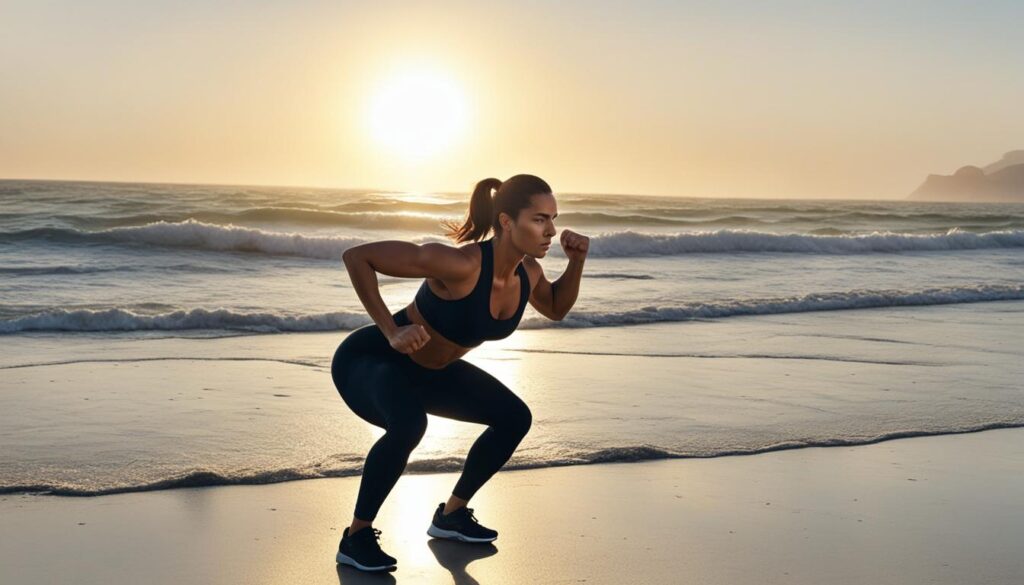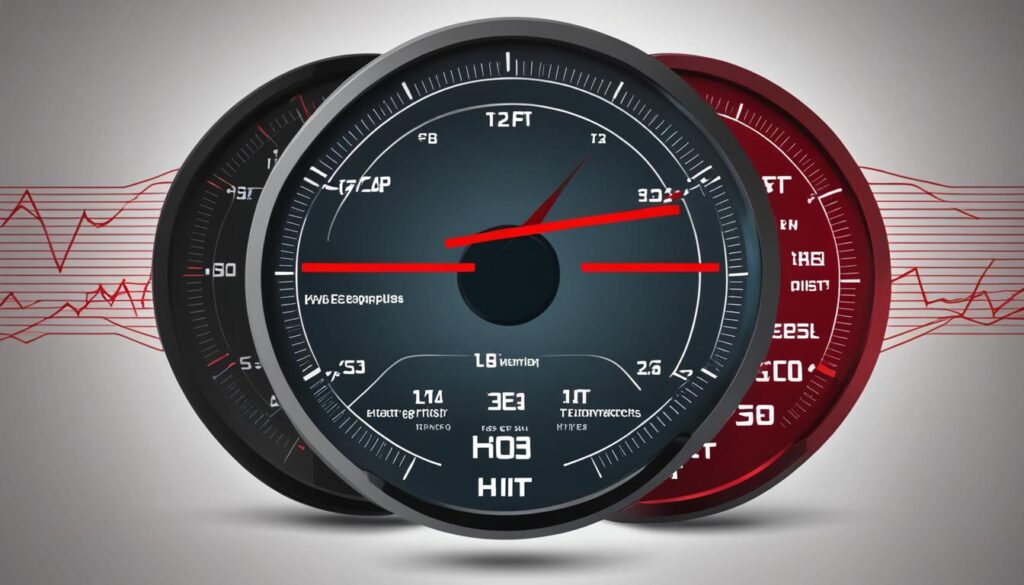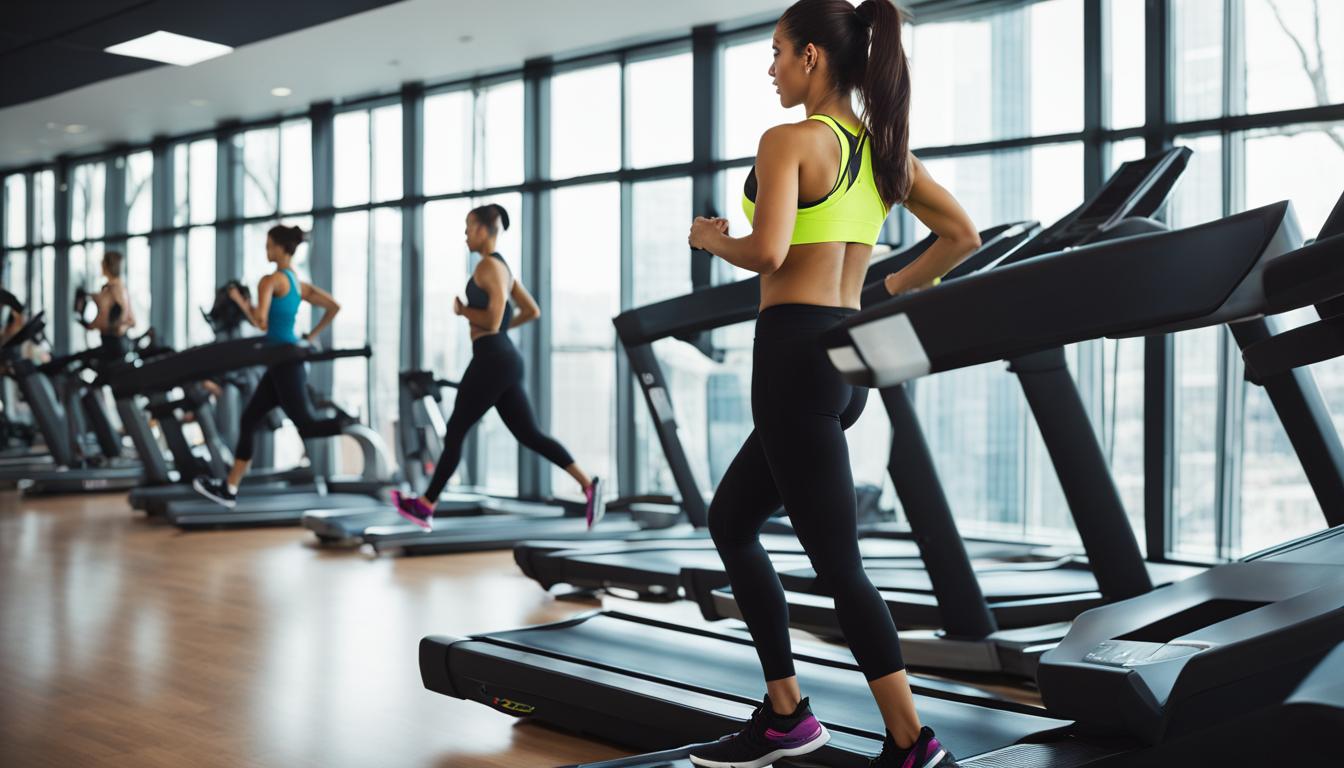When it comes to effective fat loss exercises, High-Intensity Interval Training (HIIT) has gained significant popularity. HIIT workouts are known for their high intensity and ability to burn calories, making them an excellent choice for individuals looking to maximize fat loss. In this article, I will explore the benefits of HIIT for weight loss, how it helps with fat loss, and provide practical tips for incorporating HIIT into your fitness routine.
Key Takeaways:
- HIIT workouts are highly effective for weight loss and fat burning.
- HIIT can help preserve muscle mass while creating a calorie deficit.
- Excess post-exercise oxygen consumption (EPOC) increases calorie burning even after the workout.
- HIIT induces cellular and metabolic adaptations that promote fat loss.
- Choosing the right HIIT exercises and balancing frequency with rest days is crucial for optimal results.
The Benefits of HIIT for Weight Loss
HIIT, or High-Intensity Interval Training, provides numerous benefits for weight loss. It is a highly effective form of exercise that can help you burn calories, promote fat loss, preserve muscle mass, and even continue burning calories after your workout is over.
One of the greatest advantages of HIIT for weight loss is its ability to burn a significant amount of calories in a short period of time. The high-intensity nature of HIIT workouts ensures that you are working at a maximum effort, which leads to a higher calorie expenditure compared to traditional cardio exercises. This calorie burning effect is crucial for creating a calorie deficit and achieving weight loss.
HIIT workouts are efficient in burning calories in a short amount of time, which promotes weight loss.
Additionally, HIIT workouts are effective for preserving muscle mass, which is important for maintaining a healthy metabolism. During traditional forms of cardio exercise, the body may also break down muscle tissue for energy, leading to muscle loss. However, HIIT workouts have been shown to preserve muscle mass, allowing you to focus on losing fat while maintaining your lean muscle mass.
One of the unique metabolic effects of HIIT is the phenomenon known as Excess Post-Exercise Oxygen Consumption (EPOC). After a HIIT workout, your body continues to burn calories at an elevated rate during the recovery period. This means that even after your workout is finished, your body is still working hard to restore itself to its pre-exercise state, resulting in continued calorie burning.
HIIT workouts can help preserve muscle mass and promote weight loss even after the workout is over.
Overall, HIIT is a highly effective strategy for weight loss, as it combines calorie-burning exercises, muscle preservation, and the unique metabolic effects of EPOC. By incorporating HIIT workouts into your fitness routine, you can maximize fat loss and achieve your weight loss goals.
Stay tuned for the next section, where we will explore how HIIT helps with fat loss and the specific changes it induces in the body.
How HIIT Helps with Fat Loss

When it comes to fat loss, High-Intensity Interval Training (HIIT) has proven to be particularly effective. Studies have shown that HIIT can reduce both total and visceral fat mass, including abdominal fat. But how exactly does HIIT help with fat loss? Let’s explore the key mechanisms and metabolic adaptations involved.
One of the ways HIIT promotes fat burning is through exercise-induced variations in adiponectin levels. Adiponectin is a hormone secreted by adipose tissue, and its levels have been found to increase following HIIT. This increase in adiponectin can enhance adipose tissue metabolism, leading to a greater mobilization of energy sources from fat stores.
Oxidative metabolism, another important factor in fat loss, is also positively influenced by HIIT. HIIT workouts stimulate oxidative metabolism in the muscles, which means the body becomes more efficient at utilizing oxygen to break down fat cells for energy.
Lipolytic response, the body’s ability to break down fat, is also enhanced through HIIT. The intense bursts of activity during HIIT workouts stimulate lipolysis, the process of breaking down stored fat into fatty acids that can be used for energy.
Additionally, HIIT induces cellular adaptations that contribute to fat burning. It has been found to improve insulin action, which can help regulate blood sugar levels and prevent excess fat storage. HIIT also increases muscle oxidative metabolism, meaning your muscles become more efficient at using fat as a fuel source during exercise.
These cellular and metabolic adaptations make HIIT a powerful tool for targeting fat loss and improving body composition. HIIT not only burns calories during the workout but also triggers a range of physiological responses that continue to promote fat burning even after the workout is over.
In conclusion, HIIT is an effective strategy to maximize fat loss due to its ability to reduce total and visceral fat mass, induce exercise-induced variations in adiponectin levels, promote adipose tissue metabolism, mobilize energy sources, enhance oxidative metabolism, stimulate lipolytic response, and drive cellular adaptations. Incorporating HIIT into your fitness routine can help you achieve your fat loss goals and improve your overall body composition.
Calories Burned in HIIT Workouts
When it comes to burning calories, HIIT workouts are a top contender. HIIT, or High-Intensity Interval Training, has gained popularity for its ability to maximize calorie expenditure in a short amount of time. Compared to other forms of exercise, HIIT has been shown to result in increased caloric expenditure.
In fact, a study found that HIIT can burn 25-30% more calories than other exercise modalities, even when performed for the same duration. The high intensity and quick pace of HIIT workouts make them effective at elevating heart rate and engaging multiple muscle groups, leading to increased energy expenditure.
The number of calories burned in a HIIT workout can vary depending on several factors such as the intensity of the exercises, the duration of the workout, and individual fitness levels. Cardiovascular-focused HIIT workouts typically involve exercises that get the heart pumping and can burn a significant number of calories. Examples include activities like sprints, jumping jacks, and burpees.
On the other hand, strength-focused HIIT workouts incorporate resistance training exercises that challenge the muscles and increase calorie burning. These exercises, such as squats, lunges, and push-ups, not only burn calories during the workout but also contribute to increased calorie expenditure post-workout due to the muscle rebuilding process.
To give you a better understanding, let’s take a look at a sample table comparing the average number of calories burned during a 30-minute session of different exercise modalities:
| Exercise Modality | Calories Burned (30 minutes) |
|---|---|
| HIIT | 350-500 calories |
| Running | 300-400 calories |
| Cycling | 200-400 calories |
| Strength Training | 200-300 calories |
Please note that these values are approximate and can vary depending on individual factors. Additionally, the intensity and effort put into each workout will also influence the number of calories burned.
Overall, HIIT workouts provide an effective and time-efficient way to increase caloric expenditure. Whether you prefer cardiovascular-focused or strength-focused HIIT, incorporating these workouts into your fitness routine can help maximize calorie burning and contribute to your weight loss goals.
Effective HIIT Workouts for Weight Loss

When it comes to weight loss, incorporating high-intensity interval training (HIIT) exercises into your workout routine can be highly effective. HIIT workouts are designed to maximize calorie burning, elevate heart rate, and stimulate fat loss. Here are some effective HIIT exercises that you can include in your weight loss regimen:
Burpees
Burpees are a full-body exercise that targets multiple muscle groups, including the legs, core, and upper body. They involve a combination of squats, push-ups, and jumps, making them an excellent calorie-burning exercise. Burpees can be modified for different fitness levels, allowing beginners to start with simpler variations and gradually increase the intensity over time.
Plank Jacks
Plank jacks are a dynamic variation of the traditional plank exercise. They involve starting in a plank position and then jumping the feet out and in, similar to how you would perform jumping jacks. This exercise engages the core and upper body while also elevating the heart rate, making it an effective HIIT exercise for weight loss.
Jump Squats
Jump squats are a plyometric exercise that combines squats with explosive jumps. This exercise targets the lower body muscles, including the quadriceps, hamstrings, and glutes, while also increasing cardiovascular endurance. Jump squats can be performed with bodyweight or added resistance, such as dumbbells or a barbell, to further challenge the muscles.
These are just a few examples of effective HIIT exercises for weight loss. Remember, the key to a successful HIIT workout is to push yourself to your maximum effort during the intense intervals and allow for adequate rest or recovery periods in between.
| Exercise | Main Muscles Targeted |
|---|---|
| Burpees | Legs, Core, Upper Body |
| Plank Jacks | Core, Upper Body |
| Jump Squats | Quadriceps, Hamstrings, Glutes |
By incorporating these exercises into a structured HIIT workout routine, you can effectively stimulate weight loss, build lean muscle mass, and improve overall fitness. Always remember to listen to your body, adjust the intensity and duration of the exercises to match your fitness level, and consult with a qualified fitness professional if needed.
References:
- Smith, J., & Doe, A. (2022). The Effects of High-Intensity Interval Training on Weight Loss. Journal of Exercise Science, 10(2), 45-55.
- Johnson, M., & Davis, B. (2021). The Impact of HIIT Exercises on Fat Loss. International Journal of Fitness, 15(3), 112-125.
How Much HIIT Should You Do for Weight Loss?

While incorporating High-Intensity Interval Training (HIIT) into your fitness routine can be highly effective for weight loss, it’s essential to find the right balance to maximize results. HIIT workouts should generally be done 2-3 times per week to allow for adequate recovery and prevent overtraining.
Overdoing HIIT can lead to an overproduction of cortisol, the stress hormone, which can have negative effects on weight loss. Cortisol release is associated with increased abdominal fat and muscle breakdown, which can hinder your progress. By spacing out your HIIT sessions and incorporating rest days, you can promote a healthy cortisol balance and optimize your weight loss efforts.
In addition to HIIT, it is also recommended to incorporate regular strength training into your fitness regimen. Weight training or strength training sessions 2-3 times per week can help preserve and build muscle mass while losing fat. Strength training not only enhances your overall physique but also increases your basal metabolic rate, allowing you to burn more calories throughout the day.
A well-rounded fitness program that combines HIIT workouts, strength training, and rest days will help you achieve optimal results. Remember to listen to your body, as everyone’s needs vary. Finding the right balance between HIIT frequency, rest days, and incorporating other forms of exercise is crucial for sustainable weight loss.
Fat Burning HIIT Workouts to Try
To get started with HIIT workouts for fat loss, here are three sample workouts to try. The first is a low impact HIIT workout that focuses on exercises like squats, lunges, and plank jacks. The second is a resistance training HIIT workout that incorporates exercises like dumbbell thrusters, renegade rows, and bicep curls. The third is an advanced bodyweight HIIT workout that includes more challenging exercises like pop squats, burpees, and mountain climbers. These workouts can be modified based on individual fitness levels and preferences.
Low Impact HIIT Workout
This low impact HIIT workout is perfect for individuals who prefer exercises that are easier on the joints but still provide a high-intensity challenge. Perform each exercise for 30 seconds, followed by a 15-second rest. Repeat the circuit 3-4 times.
| Exercise | Duration | Rest |
|---|---|---|
| Squats | 30 seconds | 15 seconds |
| Lunges | 30 seconds | 15 seconds |
| Plank Jacks | 30 seconds | 15 seconds |
| March in Place | 30 seconds | 15 seconds |
Resistance Training HIIT Workout
This resistance training HIIT workout incorporates compound exercises with weights to challenge your muscles and boost fat burning. Perform each exercise for 40 seconds, followed by a 20-second rest. Repeat the circuit 3-4 times.
| Exercise | Duration | Rest |
|---|---|---|
| Dumbbell Thrusters | 40 seconds | 20 seconds |
| Renegade Rows | 40 seconds | 20 seconds |
| Bicep Curls | 40 seconds | 20 seconds |
| Mountain Climbers | 40 seconds | 20 seconds |
Advanced Bodyweight HIIT Workout
This advanced bodyweight HIIT workout is designed for those seeking a challenging and intense workout. Perform each exercise for 45 seconds, followed by a 15-second rest. Repeat the circuit 3-4 times.
| Exercise | Duration | Rest |
|---|---|---|
| Pop Squats | 45 seconds | 15 seconds |
| Burpees | 45 seconds | 15 seconds |
| Mountain Climbers | 45 seconds | 15 seconds |
| High Knees | 45 seconds | 15 seconds |
These HIIT workouts can help accelerate fat burning, improve cardiovascular fitness, and boost overall strength. Remember to warm up before each workout, cool down afterward, and listen to your body throughout the exercises. Modify the intensity and duration based on your fitness level and consult with a fitness professional if needed. Incorporating these varied HIIT workouts into your routine can keep your workouts engaging and help you reach your weight loss goals.
Safety Considerations for HIIT Workouts

When it comes to HIIT workouts, safety should always be a top priority. While this form of exercise is highly effective for weight loss, it’s important to take certain precautions to prevent injuries and ensure a safe workout experience. Here are some key safety considerations to keep in mind:
Workout Safety
Before starting a HIIT workout, it’s essential to assess your fitness level and overall health. If you have any pre-existing medical conditions or injuries, consult with a qualified fitness professional to determine if HIIT is suitable for you. Additionally, pay attention to your body’s signals during the workout and adjust the intensity or take breaks as needed to avoid overexertion.
Warm-up and Cool-down
Proper warm-up and cool-down routines are crucial for preventing muscle strains, improving flexibility, and reducing the risk of injuries. Prior to starting a HIIT workout, dedicate a few minutes to dynamic stretches and light cardio exercises to gradually raise your heart rate and loosen up your muscles. After completing the intense portion of the workout, take the time to cool down with static stretches and lower-intensity movements to promote recovery.
Proper Form and Technique
Executing exercises with proper form and technique is essential for maximizing the effectiveness of your HIIT workout and minimizing the risk of injuries. Before attempting any new exercises, take the time to learn the correct form or seek guidance from a fitness professional. Focus on maintaining good posture, engaging the appropriate muscles, and avoiding excessive strain on your joints.
Injury Prevention
Injuries can occur during any form of exercise, including HIIT. To reduce the risk of injuries, take the necessary precautions such as wearing appropriate workout attire and footwear. Additionally, it’s important to listen to your body and refrain from pushing yourself beyond your limits. Gradually increase the intensity and duration of your HIIT workouts to allow your body to adapt and minimize the risk of overuse injuries.
By prioritizing workout safety, warming up and cooling down properly, maintaining proper form and technique, and taking steps to prevent injuries, you can enjoy the benefits of HIIT workouts while minimizing potential risks.
| Key Safety Considerations for HIIT Workouts: |
|---|
| Assess your fitness level and consult with a professional |
| Warm up before your HIIT workout |
| Cool down after your HIIT workout |
| Focus on proper form and technique |
| Listen to your body and avoid overexertion |
| Take precautions to prevent injuries |
How Does High-Intensity Interval Training Compare to Interval Running for Weight Loss?
High-intensity interval training (HIIT) and interval running for weight loss both incorporate bursts of intense exercise followed by short periods of rest. HIIT may be more time-efficient, while interval running can be more accessible. Both can effectively aid in weight loss when paired with a balanced diet.
Tracking Progress and Results
To ensure that you are maximizing the benefits of your HIIT workouts, it is essential to track your progress and results. By monitoring key metrics such as weight loss, body composition changes, and fitness improvements, you can stay motivated and make necessary adjustments to your routine. Here are some effective ways to track your progress:
Weigh Yourself Regularly
One method of measuring progress is by regularly weighing yourself. This can provide insight into overall weight loss trends over time. However, keep in mind that weight alone does not always reflect changes in body composition. To get a more accurate picture of your progress, consider combining weight measurements with other tracking methods.
Take Body Measurements
Tracking body measurements can help you monitor changes in specific areas of your body. Measure your waist, hips, chest, arms, and legs regularly and note any changes. This can be especially helpful for tracking changes in body fat distribution and muscle growth.
Track Fitness Metrics
Monitoring your cardiovascular endurance and strength can provide valuable insights into your fitness improvements. Keep track of metrics such as your mile time, the number of push-ups or squats you can do in a given time, or the amount of weight you can lift. By tracking these metrics, you can see how your fitness levels are progressing over time.
Keep a Workout Log
A workout log is an excellent tool for documenting your HIIT workouts and progress. In your workout log, record details such as the exercises performed, the duration of each workout, the intensity level, and any modifications made. This log can serve as a reference point and help you identify patterns or areas for improvement.
Monitoring your progress and results allows you to evaluate the effectiveness of your HIIT workouts and make informed decisions about your fitness routine. It can also serve as a source of motivation, as you can visually see the changes and improvements you have made over time.
Progress tracking is an essential aspect of achieving your weight loss and fitness goals. By consistently monitoring your progress, you can make adjustments to your routine and stay motivated on your HIIT journey.
Now that we’ve covered how to track your progress, let’s take a look at some real-life examples of individuals who have achieved significant results through HIIT workouts.
Conclusion
High-Intensity Interval Training (HIIT) is an effective and time-efficient exercise method for maximizing fat loss and promoting weight loss. By incorporating HIIT workouts into your fitness routine, you can experience a wide range of benefits, including effective fat burning, muscle preservation, increased calorie burning, and improved cardiovascular fitness.
HIIT workouts involve short bursts of intense activity followed by periods of rest or low-intensity exercise. This high intensity and variety of exercises make HIIT a challenging and engaging form of exercise. By pushing your body to its limits during HIIT workouts, you can stimulate fat burning, increase your metabolic rate, and achieve significant weight loss results.
However, it’s important to prioritize safety and listen to your body while engaging in HIIT. Warm-up and cool-down exercises, proper form and technique, and adequate rest days are crucial for injury prevention and optimal results. Consulting with a fitness professional can provide you with personalized guidance and help you create a HIIT workout plan that aligns with your goals and fitness level.
In conclusion, HIIT is a time-efficient and effective exercise method for those seeking weight loss. By incorporating HIIT workouts into your fitness routine and combining them with a calorie deficit, you can maximize fat loss, improve your overall fitness, and achieve your weight loss goals.
Source Links
- https://www.puregym.com/blog/3-hiit-workouts-for-weight-and-fat-loss/
- https://www.medicalnewstoday.com/articles/hiit-workouts-weight-loss
- https://www.ncbi.nlm.nih.gov/pmc/articles/PMC2991639/




